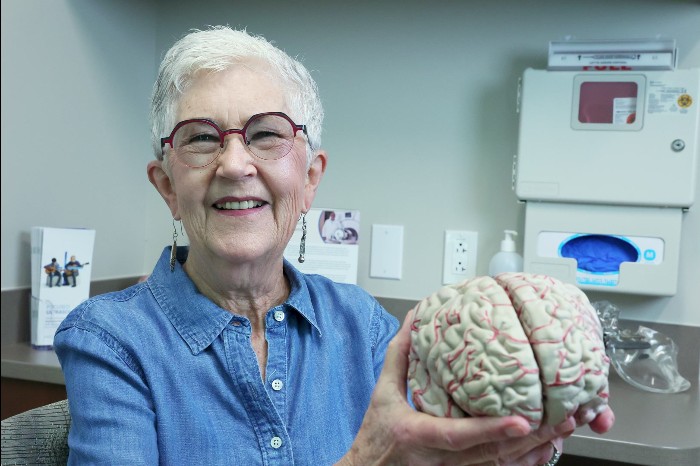 For 20 years, Phyllis Lair dealt with a shaky left hand. The 76-year-old College Station resident, who is left-hand dominant, had watched her own mother endure similar symptoms and knew that her condition was inherited.
For 20 years, Phyllis Lair dealt with a shaky left hand. The 76-year-old College Station resident, who is left-hand dominant, had watched her own mother endure similar symptoms and knew that her condition was inherited.
Lair saw a neurologist in College Station and was diagnosed with essential tremor, a neurological condition believed to be caused by disruption of signals that control movement in the brain. Over the years, she also developed shaking of her head and neck. She was prescribed medication that helped control these unwanted movements at first.
Within the past three years, however, Lair noticed the medication was no longer working, even though she was using the maximum dosage. After her neurologist added a second medication to her daily regimen, Lair’s hand continued to shake uncontrollably.
“I couldn’t write anymore,” she recalls. “Putting on eye makeup was a problem, and I could no longer measure ingredients when I cooked. I avoided eating soup in restaurants and carrying a cup of coffee was difficult.”
As the owner of two restaurants who kept the books and managed payroll, her inability to write with her dominant hand drove her to seek a different treatment option.
“I saw ads on social media about this new ultrasound procedure to help people with essential tremor,” she remembers, “so I asked my neurologist, Dr. Boyle, about this.”
Allison Boyle, MD, a board-certified neurologist with Mischer Neuroscience Associates (MNA) in The Woodlands specializes in neurology and movement disorders. She referred Lair to her colleague, Sam Javedan, MD, a board-certified neurosurgeon also with MNA.
 Dr. Javedan determined that Lair was a candidate for a non-invasive treatment known as MR-guided focused ultrasound (MRgFUS), which was approved by the FDA for the treatment of essential tremor. During the procedure magnetic resonance imaging (MRI) is used to pinpoint the part of the brain causing the tremor, and focused ultrasound delivers soundwaves directly to the brain to heat, or ablate, the area and disrupt the signals from the brain to the affected hand. Lair opted to undergo the procedure in September 2023.
Dr. Javedan determined that Lair was a candidate for a non-invasive treatment known as MR-guided focused ultrasound (MRgFUS), which was approved by the FDA for the treatment of essential tremor. During the procedure magnetic resonance imaging (MRI) is used to pinpoint the part of the brain causing the tremor, and focused ultrasound delivers soundwaves directly to the brain to heat, or ablate, the area and disrupt the signals from the brain to the affected hand. Lair opted to undergo the procedure in September 2023.
“Ms. Lair was a candidate for this procedure because her medications were no longer effective in managing her hand and forearm tremor,” Dr. Javedan says. “A pre-operative CT scan of her skull also determined she was a candidate because the bone density of her skull was optimal for the ultrasound to reach the area of the brain that we needed to target.”
The Centers for Medicare & Medicaid Services (CMS) lists MRgFUS as a treatment option for essential tremor, paving the way for insurance coverage of the procedure. “Recent studies on the sustainability of this procedure at the five-year follow-up have shown it to be an effective way to control essential tremor,” Dr. Javedan says.
On the day of the procedure, Lair’s head was shaved to allow for the placement of a metal fixation frame around her skull to immobilize her head and to optimize the delivery of the soundwaves to her brain. The frame attaches to the skull in four areas that are numbed prior to its placement. She remained awake during the treatment.
Guided by a pre-procedure MRI that determined where to begin targeting, Dr. Javedan moved Lair into the MRI machine and administered pulses of ultrasound to the part of her brain where the tremor originated. These pulses temporarily stop the overactive tremor signals emerging from the brain. Then, Lair was brought out of the machine and asked to trace a spiral design and draw straight lines on a sheet of paper. These drawings helped Dr. Javedan determine whether he had located the exact spot needed to control the tremor.
After being taken in and out of the MRI machine to test her hand control a few times, Lair’s drawings smoothed out, indicating Dr. Javedan had successfully located the origin of the tremor. “Once we determine we’re in the right spot with the drawings, we deliver the focused ultrasound to that area at a high temperature to create a long-term lesion on the brain,” he says.
“I was put in the machine two or three times before I was able to follow the spiral and draw straight lines,” Lair recalls. “My drawings show the difference.”
The whole process lasted about three hours, and Lair was discharged. She had a follow-up MRI the next day. She said she never experienced pain – just pressure – and only felt a “little wobbly” and tired the next day. These are common side effects that Dr. Javedan had informed her she might experience.
At her three-month follow up in January 2024, Lair underwent another MRI to check if her brain had healed properly. Her hand control was also evaluated. Dr. Javedan says with this procedure, most people can maintain 80%t control of their tremors three months after the treatment, and studies show that result is maintained for at least five years.
Since her procedure, Lair can write again and has returned to bookkeeping and managing payroll for her two restaurants. She also regularly cares for eight of her 16 grandchildren and is thrilled with her results.
“I would do this again in a heartbeat and recommend it for anyone with essential tremor,” she says. “It changes your life and takes you back to the way you should be.”